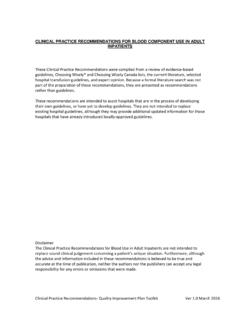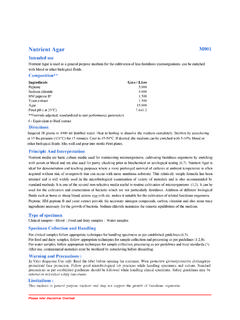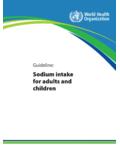Transcription of Obstetric Hemorrhage Care Guidelines: Checklist …
1 Obstetric Hemorrhage care guidelines : Checklist Format version Prenatal Assessment & Planning Identify and prepare for patients with special considerations: Placenta Previa/Accreta, Bleeding Disorder, or those who Decline blood Products Screen and aggressively treat severe anemia: if oral iron fails, initiate IV Iron Sucrose Protocol to reach desired Hgb/Hct, especially for at risk mothers. Admission Assessment & Planning Ongoing Risk Assessment Verify Type & Antibody Screen from prenatal record If not available, Order Type & Screen (lab will notify if 2nd clot needed for confirmation) If prenatal or current antibody screen positive (if not low level anti-D from Rho-GAM), Type & Crossmatch 2 units PRBCs All other patients, Send Clot to blood bank Evaluate for Risk Factors (see below) If medium risk: Order Type & Screen Review Hemorrhage Protocol If high risk: Order Type & Crossmatch 2 units PRBCs Review Hemorrhage Protocol Notify OB Anesthesia Identify women who may decline transfusion Notify OB provider for plan of care Early consult with OB anesthesia Review Consent Form Evaluate for development of additional risk factors in labor.
2 Prolonged 2nd Stage labor Prolonged oxytocin use Active bleeding Chorioamnionitis Magnesium sulfate treatment Increase Risk level (see below) and convert to Type & Screen or Type & Crossmatch Treat multiple risk factors as High Risk Admission Hemorrhage Risk Factor Evaluation Low (Clot only) Medium (Type and Screen) High (Type and Crossmatch) No previous uterine incision Prior cesarean birth(s) or uterine surgery Placenta previa, low lying placenta Singleton pregnancy Multiple gestation Suspected Placenta accreta or percreta 4 previous vaginal births >4 previous vaginal births Hematocrit <30 AND other risk factors No known bleeding disorder Chorioamnionitis Platelets <100,000 No history of PPH History of previous PPH Active bleeding (greater than show) on admit Large uterine fibroids Known coagulopathy Estimated fetal weight greater than 4 kg Morbid obesity (BMI >35) STAGE 0: All Births: Prevention & Recognition of OB Hemorrhage Active Management of Third Stage Oxytocin infusion: 10-20 units oxytocin/1000ml solution titrate infusion rate to uterine tone; or 10 units IM; do not give oxytocin as IV push Vigorous fundal massage for at least 15 seconds Ongoing Quantitative Evaluation of blood Loss Using formal methods, such as graduated containers, visual comparisons and weight of blood soaked materials (1gm = 1ml) Ongoing Evaluation of Vital Signs If: Cumulative blood Loss >500ml vaginal birth or >1000ml C/S -OR- Vital signs >15% change or HR 110, BP 85/45, O2 sat <95% -OR- Increased bleeding during recovery or postpartum, proceed to STAGE 1 California Maternal Quality care Collaborative (CMQCC): Hemorrhage Taskforce (2009) visit: for details Page 1 of 4 This project was supported by Title V funds received from the State of California Department of Public Health, Center for Family Health.
3 Maternal Child and Adolescent Health Division STAGE 1: OB Hemorrhage Cumulative blood Loss >500ml vaginal birth or >1000ml C/S -OR- Vital signs >15% change or HR 110, BP 85/45, O2 sat <95% -OR- Increased bleeding during recovery or postpartum MOBILIZE ACT THINK Primary nurse, Physician or Midwife to: Activate OB Hemorrhage Protocol and Checklist Primary nurse to: Notify obstetrician (in-house and attending) Notify charge nurse Notify anesthesiologist Primary nurse: Establish IV access if not present, at least 18 gauge Increase IV fluids rates (Lactated Ringers preferred) and increase Oxytocin rate (500 mL/hour of 10-40 units/1000mL solution); Titrate Oxytocin infusion rate to uterine tone Continue vigorous fundal massage Administer Methergine mg IM per protocol (if not hypertensive); give once, if no response, move to alternate agent; if good response, may give additional doses q 2 hr Vital Signs, including O2 sat & level of consciousness (LOC) q 5 minutes Weigh materials, calculate and record cumulative blood loss q 5-15 minutes Administer oxygen to maintain O2 sats at >95% Empty bladder: straight cath or place Foley with urimeter Type and Crossmatch for 2 units Red blood Cells STAT (if not already done) Keep patient warm Physician or midwife: Rule out retained Products of Conception, laceration, hematoma Surgeon (if cesarean birth and still open) Inspect for uncontrolled bleeding at all levels, esp.
4 Broad ligament, posterior uterus, and retained placenta Consider potential etiology: Uterine atony Trauma/Laceration Retained placenta Amniotic Fluid Embolism Uterine Inversion Coagulopathy Placenta Accreta Uterine Rupture Once stabilized: Modified Postpartum management with increased surveillance If: Continued bleeding or Continued Vital Sign instability, and <1500 mL cumulative blood loss proceed to STAGE 2 UTEROTONIC AGENTS for POSTPARTUM Hemorrhage Drug Dose Route Frequency Side Effects Contraindications Storage Pitocin (Oxytocin) 10 units/ml 10-40 units per 1000 ml, rate titrated to uterine tone IV infusion Continuous Usually none Nausea, vomiting, hyponatremia ( water intoxication ) with prolonged IV admin. BP and HR with high doses, esp IV push Hypersensitivity to drug Room temp Methergine (Methylergonivine) mg IM (not given IV) -Q 2-4 hours -If no response after first dose, it is unlikely that additional doses will be of benefit Nausea, vomiting Severe hypertension, esp.
5 With rapid administration or in patients with HTN or PIH Hypertension, PIH, Heart disease Hypersensitivity to drug Caution if multiple doses of ephedrine have been used, may exaggerate hypertensive response w/possible cerebral Hemorrhage Refrigerate Protect from light Hemabate (15-methyl PG F2a) 250mcg/ml 250 mcg IM or intra-myometrial (not given IV) -Q 15-90 min -Not to exceed 8 doses/24 hrs -If no response after 3 doses, it is unlikely that additional doses will be of benefit. Nausea, vomiting, Diarrhea Fever (transient), Headache Chills, shivering Hypertension Bronchospasm Caution in women with hepatic disease, asthma, hypertension, active cardiac or pulmonary disease Hypersensitivity to drug Refrigerate Cytotec (Misoprostol) 100 or 200mcg tablets 800-1000mcg Per rectum (PR) One time Nausea, vomiting, diarrhea Shivering, Fever (transient) Headache Rare Known allergy to prostaglandin Hypersensitivity to drug Room temp California Maternal Quality care Collaborative (CMQCC): Hemorrhage Taskforce (2009) visit: for details Page 2 of 4 This project was supported by Title V funds received from the State of California Department of Public Health, Center for Family Health.
6 Maternal Child and Adolescent Health Division STAGE 2: OB Hemorrhage Continued bleeding or Vital Sign instability, and <1500 mL cumulative blood loss MOBILIZE ACT THINK Primary nurse (or charge nurse): Call obstetrician to bedside Call Anesthesiologist Activate Response Team: PHONE #:_____ Notify blood bank of Hemorrhage ; order products as directed Charge nurse: Notify Perinatologist or 2nd OB Initiate OB Hemorrhage Record If selective embolization, call-in Interventional Radiology Team and second anesthesiologist Notify nursing supervisor Assign single person to communicate with blood bank Call medical social worker or assign other family support person Team leader (OB physician): Additional uterotonic medication: Hemabate 250 mcg IM [if not contraindicated] OR Misoprostol 800-1000 mcg PR o Can repeat Hemabate up to 3 times every 20 min; (note-75% respond to first dose) Do not delay other interventions (see right column) while waiting for response to medications Bimanual uterine massage Move to OR (if on postpartum unit, move to L&D or OR) Order 2 units PRBCs and bring to the bedside Order labs STAT (CBC/Plts, Chem 12, PT/aPTT, Fibrinogen, ABG) Transfuse PRBCs based on clinical signs and response, do not wait for lab results Primary nurse: Establish 2nd large bore IV, at least 18 gauge.
7 Maintain adequate fluid volume with Lactated Ringers and adequate uterine tone with oxytocin infusion Assess and announce Vital Signs and cumulative blood loss q 5-10 minutes Set up blood administration set and blood warmer for transfusion Administer meds, blood products and draw labs, as ordered Keep patient warm Second nurse (or charge nurse): Place Foley with urimeter (if not already done) Obtain portable light and OB procedure tray or Hemorrhage cart Obtain blood products from the blood Bank Assist with move to OR (if indicated) blood Bank: Determine availability of thawed plasma, fresh frozen plasma, and platelets; initiate delivery of platelets if not present on-site Consider thawing 2 FFP (takes 30 min), use if transfusing >2 units PRBCs Prepare for possibility of massive Hemorrhage Sequentially advance through procedures and other interventions based on etiology: Vaginal birth If trauma (vaginal, cervical or uterine): Visualize and repair If retained placenta: D&C If uterine atony or lower uterine segment bleeding: Intrauterine Balloon If above measures unproductive: Selective embolization (Interventional Radiology if available & adequate experience) C-section: Uterine hemostatic suture, ,B-Lynch Suture, O Leary, Multiple Squares Intrauterine Balloon If Uterine Inversion: Anesthesia and uterine relaxation drugs for manual reduction If Amniotic Fluid Embolism: Maximally aggressive respiratory, vasopressor and blood product support If vital signs are worse than estimated or measured blood loss.
8 Possible uterine rupture or broad ligament tear with internal bleeding; move to laparotomy Once stabilized: Modified Postpartum management with increased surveillance Re-Evaluate Bleeding and Vital Signs If cumulative blood loss >1500ml, >2 units PRBCs given, VS unstable or suspicion for DIC, proceed to STAGE 3 California Maternal Quality care Collaborative (CMQCC): Hemorrhage Taskforce (2009) visit: for details Page 3 of 4 This project was supported by Title V funds received from the State of California Department of Public Health, Center for Family Health; Maternal Child and Adolescent Health Division STAGE 3: OB Hemorrhage Cumulative blood loss >1500ml, >2 units PRBCs given, VS unstable or suspicion for DIC MOBILIZE ACT THINK Nurse or Physician: Activate Massive Hemorrhage Protocol PHONE #:_____ Charge Nurse or designee: Notify advanced Gyn surgeon ( Gyn Oncologist) Notify adult intensivist Call-in second anesthesiologist Call-in OR staff Reassign staff as needed Call-in supervisor, CNS, or manager Continue OB Hemorrhage Record (In OR, anesthesiologist will assess and document VS) If transfer considered, notify ICU blood Bank: Prepare to issue additional blood products as needed stay ahead Establish team leadership and assign roles Team leader (OB physician + OB anesthesiologist, anesthesiologist and/or perinatologist and/or intensivist).
9 Order Massive Hemorrhage Pack (RBCs + FFP + 1 pheresis pack PLTS see note in right column Move to OR if not already there Repeat CBC/PLTS, Chem 12, PT/aPTT, Fibrinogen, ABG STAT q 30-60 min Anesthesiologist (as indicated): Arterial blood gases Central hemodynamic monitoring CVP or PA line Arterial line Vasopressor support Intubation Primary nurse: Announce VS and cumulative measured blood loss q 5-10 minutes Apply upper body warming blanket if feasible Use fluid warmer and/or rapid infuser for fluid & blood product administration Apply sequential compression stockings to lower extremities Circulate in OR Second nurse and/or anesthesiologist: Continue to administer meds, blood products and draw labs, as ordered Third Nurse (or charge nurse): Recorder Selective Embolization (IR) Interventions based on etiology not yet completed Prevent hypothermia, Acidemia Conservative or Definitive Surgery: Uterine Artery Ligation Hysterectomy For Resuscitation: Aggressively Transfuse Based on Vital Signs, blood Loss KEY: HIGH RATIO of FFP to RBC Either: 6:4:1 PRBCs: FFP: Platelets Or: 4:4:1 PRBCs: FFP: Platelets Unresponsive Coagulopathy: After 8-10 units PRBCs and coagulation factor replacement may consider risk/benefit of rFactor VIIa Once Stabilized: Modified Postpartum Management; consider ICU blood PRODUCTS Packed Red blood Cells (PRBC) (approx.))
10 35-40 min. for crossmatch assuming no sample is in the lab and assuming no antibodies are present) Transfuse O Negative blood if you cannot wait Best first-line product for blood loss 1 unit = 450ml volume If antibody positive, may take 1-24 hrs. for crossmatch 1 unit=450 ml volume and typically increases Hct by 3% Fresh Frozen Plasma (FFP) (approx. 35-45 min. to thaw for release) Highly desired if >2 units PRBCs given, or for prolonged PT, aPTT > control 1 unit = 180ml volume and typically increases Fibrinogen by 10mg/dL Platelets (PLTS) Local variation in time to release (may need to come from regional blood bank) Priority for women with Platelets <50,000 Single-donor Apheresis unit (= 6 units of platelet concentrates) provides 40-50k transient increase in platelets Cryoprecipitate (CRYO) (approx. 35-45 min. to thaw for release) Priority for women with Fibrinogen levels <80 10 unit pack typically raises Fibrinogen 80-100mg/dL Best for DIC with low fibrinogen and don t need volume replacement Caution: 10 units come from 10 different donors, so infection risk is proportionate.






